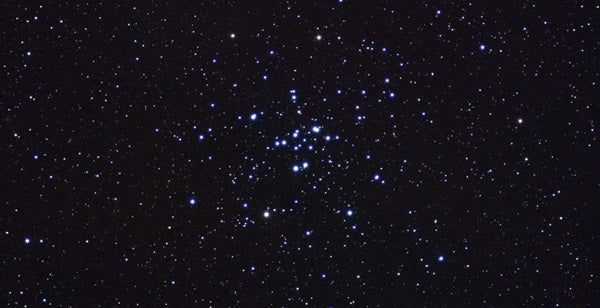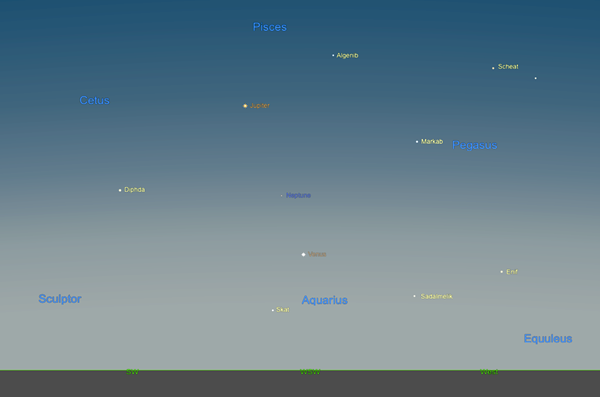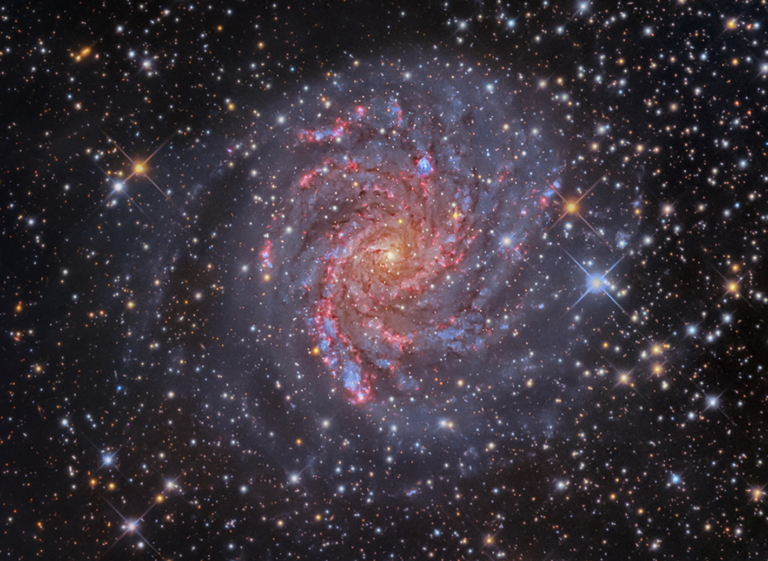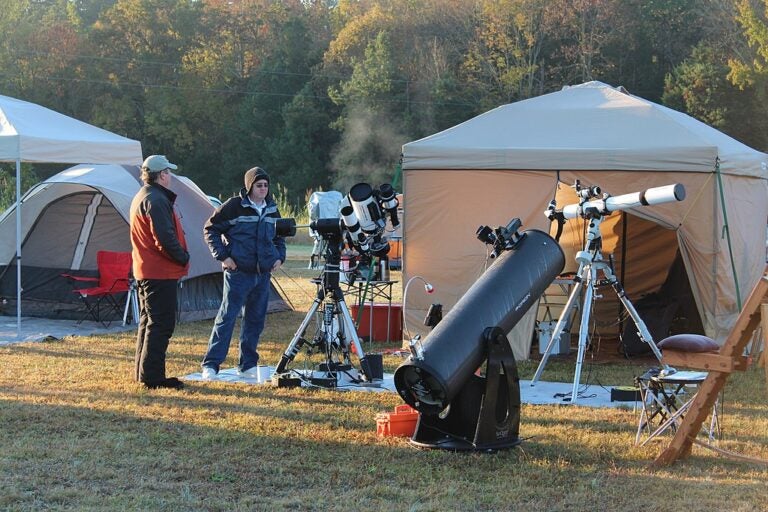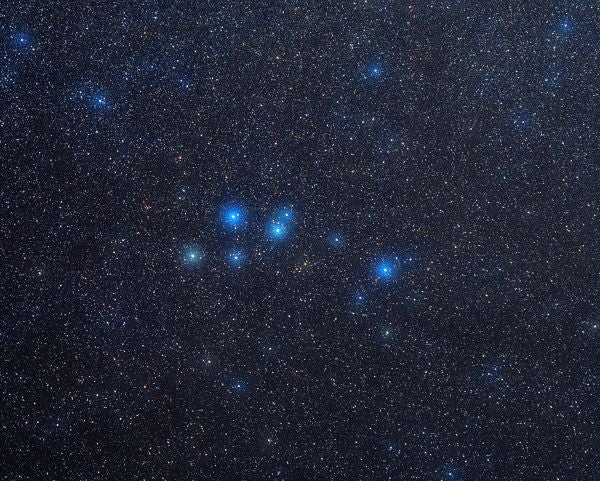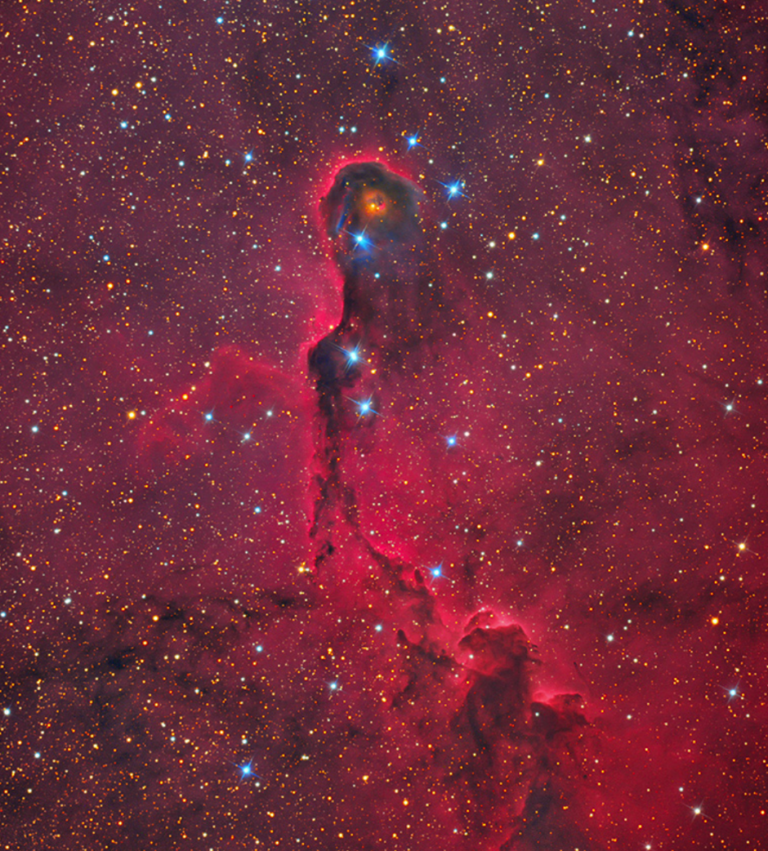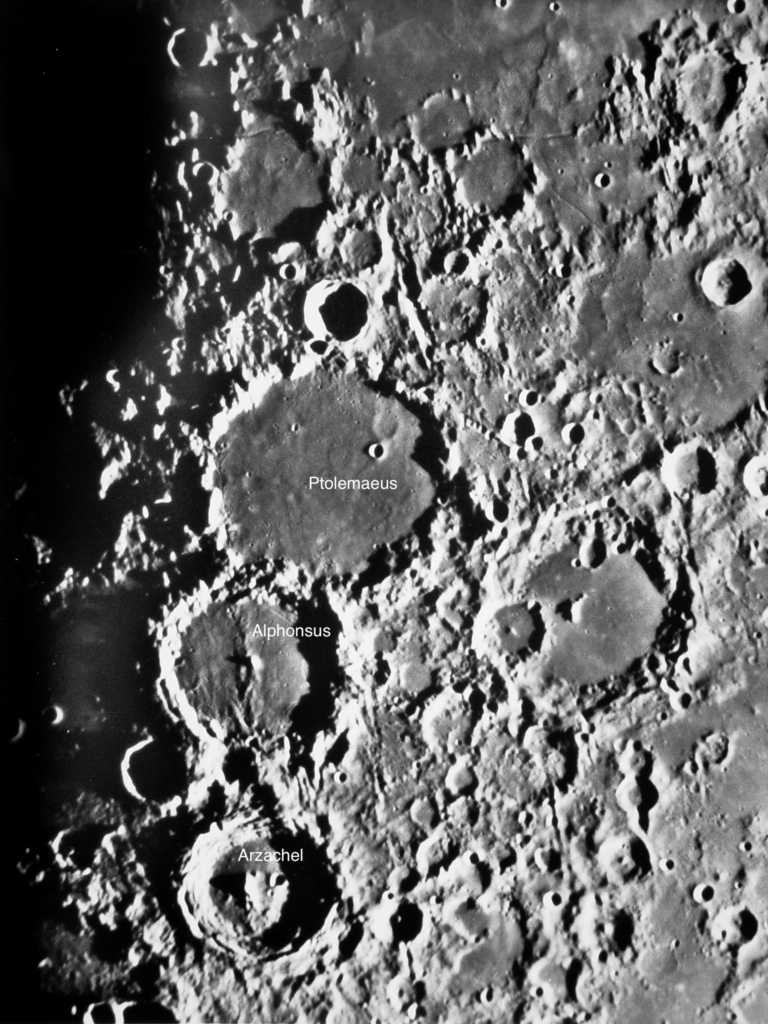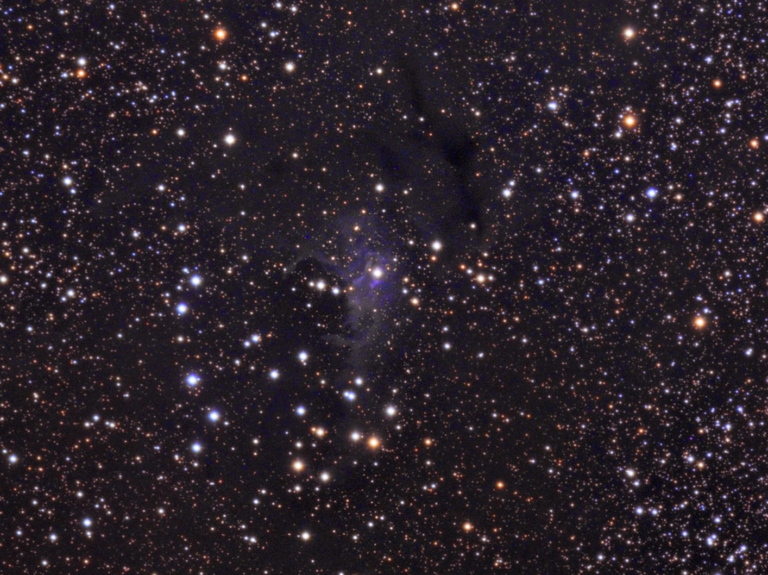Friday, February 3
A bright, nearly Full Moon rises with the heads of Gemini the Twins this evening. As the stars begin to appear, you can spot 1st-magnitude Pollux and Castor sitting (in that order) directly above the Moon in the eastern sky.
Castor is a popular target with small telescopes because it is an easy-to-split binary — these days. As these two stars orbit, their separation ranges between just less than 2″ and around 5″, their current separation. Through your scope, Castor A is the brighter of the two, shining at magnitude 1.9. Castor B is magnitude 3. But there’s also a bonus here: A third star in the system, Castor C, lies 1.2′ south of A and B, glowing much more faintly at magnitude 9.1.
Each of these three stars is a binary in itself, though these additional companions cannot be seen and were detected spectroscopically, by watching the stars’ subtle motions toward and away from us as they orbit their unseen companions.
Sunrise: 7:07 A.M.
Sunset: 5:22 P.M.
Moonrise: 3:18 P.M.
Moonset: 6:14 A.M.
Moon Phase: Waxing gibbous (96%)
*Times for sunrise, sunset, moonrise, and moonset are given in local time from 40° N 90° W. The Moon’s illumination is given at 12 P.M. local time from the same location.
Saturday, February 4
The Moon reaches apogee, the farthest point from Earth in its orbit, at 3:55 A.M. EST. At that time, it will sit 252,573 miles (406,477 kilometers) away.
Luna lies in Cancer this evening, near the Beehive Cluster (M44). On the other side of the sky, the constellation Perseus is high in the north, far above the Little Dipper. The Hero is home to many stunning deep-sky objects, including the open cluster M34. This lovely group of young stars covers some 35′ and shines collectively at magnitude 5.5. You can find M34 about 5° west-northwest of Algol, Perseus’ particularly famous 2nd-magnitude variable star.
Visible with binoculars or a telescope, M34 contains nearly a dozen stars brighter than 9th magnitude. Larger apertures will reveal even more cluster members. As an open cluster, its stars are quite young, estimated to have been born about 180 million years ago.
Algol itself is also a fascinating object: Sometimes called the Demon Star, it is an eclipsing binary whose companion passes in front of it from our point of view, causing Algol to brighten and dim by just over a full magnitude. When uneclipsed, Algol appears nearly as bright as Mirfak, 9.3° to its north. But when blocked by its companion star, Algol instead appears noticeably fainter, while Mirfak still blazes bright.
Sunrise: 7:06 A.M.
Sunset: 5:23 P.M.
Moonrise: 4:18 P.M.
Moonset: 6:53 A.M.
Moon Phase: Waxing gibbous (99%)
Sunday, February 5
Mars passes 8° north of Aldebaran in Taurus at 2 A.M. EST. At this time, East Coast observers will see Aldebaran just a few degrees above the horizon as the Bull sets in the west. For those farther west, the constellation will appear slightly higher in the sky.
Aldebaran is a red giant that glows at magnitude 0.9. Its light appears yellowish-orange, particularly through binoculars or a telescope, thanks to the aging star’s cool surface temperature. Mars now glows at magnitude –0.2 and appears to the star’s upper right as they set. To the Red Planet’s lower right is the Pleiades open cluster (M45).
If you aren’t able to catch the scene shortly after midnight, you can instead fight Taurus high in the southeast after sunset. Mars is still roughly 8° north (now to the upper left) of Aldebaran, with the Pleiades to Mars’ upper right.
Full Moon occurs at 1:29 P.M. EST. Now opposite the Sun in the sky, our satellite will rise roughly at sunset today. The February Full Moon is also called the Snow Moon, thanks to much of North America’s penchant for sitting beneath several inches of snow at this time of year.
Sunrise: 7:05 A.M.
Sunset: 5:23 P.M.
Moonrise: 5:20 P.M.
Moonset: 7:27 A.M.
Moon Phase: Full
Monday, February 6
Draco winds his way beneath the Little Dipper in the north shortly after sunset tonight. The Dragon’s head is marked by the asterism the Lozenge, which lies to the lower left (southeast) of the Litter Dipper’s bowl just after dark. There is a short dark-sky window in the hour between sunset and moonrise, so take advantage of it if you can.
The brightest star in Draco’s head is 2nd-magnitude Eltanin (Gamma [γ] Draconis). Moving counterclockwise, to the west (right) of Eltanin is Rastaban (Beta [β] Draconis; magnitude 2.8), followed by Kuma (Nu [ν] Draconis; magnitude 4.9) to Rastaban’s north. Northeast of Kuma is the last star in the Lozenge, magnitude 3.7 Grumium (Xi [ξ] Draconis).
If you look along the Dragon’s body as it curls beneath Ursa Minor, you’ll reach Thuban (Alpha [α] Draconis) some 29° west of the Lozenge. This magnitude 3.7 star was once the North Star, sitting close to Earth’s Celestial Pole as the sky appeared to spin around it. That honor now belongs to Polaris in Ursa Minor — the change is due to the fact that Earth’s rotational axis wobbles, or precesses, over the course of about 25,000 years. As the axis moves, it points at various stars in the sky at different times, so our North Star can change over the course of thousands of years.
Sunrise: 7:04 A.M.
Sunset: 5:25 P.M.
Moonrise: 6:22 P.M.
Moonset: 7:55 A.M.
Moon Phase: Waning gibbous (99%)
Tuesday, February 7
Venus is slowly approaching Neptune in the evening sky; the two planets will mingle close for two days in about a week. For now, they remain 9° apart, but you can still use Venus as a blazing beacon to point you toward our solar system’s farthest planet.
By about 40 minutes after sunset, Venus is the brightest object in the sky, a dazzling diamond at magnitude –3.9 in the west. It sits 15° above the horizon in Aquarius, with the brightest stars of that constellation just beginning to peek out from the falling twilight. With binoculars, start at Venus and scan upward, moving in a straight line toward the next-brightest object around, magnitude –2.1 Jupiter in Cetus. Jupiter lies 22.5° east of Venus, and Neptune (a dim magnitude 7.8, requiring those binoculars to spot) sits roughly halfway between them, about 7.5° south of the Circlet of Pisces (once these stars begin to appear).
Venus will move eastward at a quick clip in the coming days; after passing Neptune next week, it will close in on Jupiter, setting up a beautiful conjunction on March 2.
Sunrise: 7:03 A.M.
Sunset: 5:26 P.M.
Moonrise: 7:23 P.M.
Moonset: 8:19 A.M.
Moon Phase: Waning gibbous (96%)
Wednesday, February 8
Dwarf planet 1 Ceres stands stationary against the background stars at 3 P.M. EST. The main-belt world is now located in Virgo, sharing the constellation with the slowly waning Moon.
If you like to rise early, you can catch Virgo slowly setting in the southwest around 5 A.M. local time this morning. The Moon is slowly closing in on Ceres’ location about 3.5° due west of 3rd-magnitude Vindemiatrix (Epsilon [ϵ] Virginis). Nearby (to Ceres’ west) are several bright galaxies in the Virgo Cluster, though the bright moonlight will make finding these difficult in a smaller scope. If you have a medium or large aperture, though, it’s still worth a try! The massive, bright galaxy M87 (magnitude 8.6) is your best bet. It lies just under 4.5° west-northwest of Ceres’s location.
Alternatively, you can catch this same region rising in the east around 9 P.M. local time tonight. Note, though that the Moon is slightly less illuminated but has moved much closer to Ceres’ position, now sharing Virgo with the dwarf planet instead of keeping its distance in Leo, where our satellite sat early this morning. Because Ceres is stationary, you’ll find it in the same location, just west of Vindemiatrix.
Sunrise: 7:01 A.M.
Sunset: 5:28 P.M.
Moonrise: 8:24 P.M.
Moonset: 8:41 A.M.
Moon Phase: Waning gibbous (92%)
Thursday, February 9
Mercury is growing brighter in the morning sky, now magnitude –0.1. You can try spotting it in the southeast about half an hour before sunrise, when the innermost planet is 5.5° high and rising. It should stand out against the brightening twilight, but binoculars or a telescope will certainly show its small disk. Mercury now appears 6″ across and is some 77 percent lit.
A few bright stars may still appear in the sky, especially the longer before sunrise you look. Antares, at magnitude 1.1, may be visible in Scorpius to Mercury’s right. And Altair, a magnitude 0.8 star in Aquila, might appear to Mercury’s upper left. The waning Moon, meanwhile, is still well above the horizon in the west, lingering in Virgo. Take some time to enjoy Earth’s natural satellite as sunlight begins to brighten the sky. Before it gets too bright, though, can you make out 1st-magnitude Spica to our satellite’s upper left?
Remember that if you do any skygazing just before dawn, make sure to note the time of sunrise from your location (which may differ from that given below). Put away any binoculars or telescopes at least several minutes before the Sun is scheduled to first peek above the horizon.
Sunrise: 7:00 A.M.
Sunset: 5:29 P.M.
Moonrise: 9:25 P.M.
Moonset: 9:02 A.M.
Moon Phase: Waning gibbous (86%)
Friday, February 10
Comet C/2022 (E3) ZTF, which was recorded around magnitude 5 a week ago, is now skimming away from the North Celestial Pole and passing close to Mars. After dark, look for the Red Planet, glowing at magnitude 0 in the southeastern sky.
Swing binoculars or a small scope up to Mars’ location about an hour and a half after sunset, then look 1.7° northeast. You should land right on ZTF, glowing softly green as dicarbon in its atmosphere fluoresces. It’s a stunning sight, and wide-field scopes should be able to capture both in the same field of view. Additioanlly, the open cluster NGC 1746 lies about 4° to ZTF’s southeast, or nearly 5° east-southeast of Mars.
Any camera capable of taking long-exposure shots should capture the scene beautifully in the sky above the landscape of your choosing, accompanied by the Pleiades to the right (west) and Orion to the lower left (southeast).
Note that the comet is still moving quickly, covering nearly 3° per night, though it is slowing down. By the same time tomorrow night, ZTF will have slid due south and will appear 1.8° southeast of Mars.
Sunrise: 6:59 A.M.
Sunset: 5:30 P.M.
Moonrise: 10:27 P.M.
Moonset: 9:23 A.M.
Moon Phase: Waning gibbous (79%)


